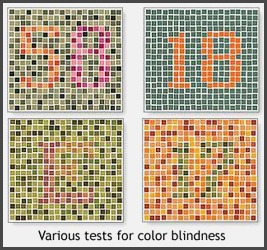What is it?
Colour blindness is not a form of blindness at all, but a deficiency in the way you see colour. With this vision problem, you have difficulty distinguishing certain colours, such as blue and yellow or red and green.
Red-green colour deficiency is the most common form of colour blindness, affecting about 2% to 6% of all men. Much more rarely, a person may inherit a trait that reduces the ability to see blue and yellow hues. This blue-yellow colour deficiency usually affects men and women equally.
Causes?
Colour blindness occurs when light-sensitive cells in the retina fail to respond appropriately to variations in wavelengths of light that enable people to see an array of colours.
More men than women have colour blindness, about 1 in 10 men have some form of colour blindness, very few women are colour blind. Majority of people with a colour deficiency are born with it.

Photo-receptors in the retina include rods that enhance vision in low lighting, and cones that help us see in colour. Inherited forms of colour blindness often are related to deficiencies in certain types of cones or an outright absence of these cones.
Besides differences in genetic make-up, other causes of colour vision defects or loss include:
- Parkinson’s disease.
- Cataracts.
- Hydroxychloroquine, a drug used to treat rheumatoid arthritis, among other conditions.
- Tiagabine, an anti epileptic drug.
- Leber’s hereditary optic neuropathy.
- Kallman’s syndrome.
Colour blindness can also occur when aging processes damage retinal cells. An injury or damage to areas of the brain where vision processing takes place also can cause colour vision deficiencies.
What are the symptoms?
Do you have difficulty telling if colours are blue and yellow, or red and green? Do other people sometimes inform you that the colour you think you are seeing is wrong? If so, these are primary signs that you have a colour vision deficiency.
Symptoms vary from person to person, but may include;
- Trouble seeing colours and the brightness of colours in the usual way
- Inability to tell the difference between shades of the same or similar colours
Often, the symptoms may be so mild that some persons do not know they are colour blind. A parent may notice signs of colour blindness when a child is learning their colours.
Rapid, side-to-side eye movements and other symptoms may occur in severe cases.
Contrary to popular belief, it is rare for a colour blind person to see only in shades of grey.
How is colour blindness detected?
Your optometrist can check your colour vision in a number of ways, all of which are quick and painless. Testing for colour blindness is commonly done during a comprehensive eye exam with an optometrist.
Colour vision testing can help determine the type of colour deficiency you have.
What treatments are available?
There is no known treatment for colour blindness. Colour blindness is a life-long condition. Some coping strategies may help you function better in a colour-oriented world.
Most people are able to adjust to colour vision deficiencies without difficulty or disability, but some professions, such as graphic design and occupations that require handling various colours of electrical circuits depend on accurate colour perception.
Hence, a colour vision test is especially important in relation to vocational decisions.
Make an appointment with your optometrist if you think you (or your child) have colour blindness.

